The "Magnificent Seven" of the US stock market
The Magnificent Seven was coined earlier this year by Michael Hartnett, an investment strategist at Bank of America. He emphasized that the seven largest companies in the S&P 500 have accounted for most of the index's returns this year.
Apple, Microsoft, Alphabet, Amazon, NVIDIA, Tesla and Meta represent more than 28% of the S&P 500. We would have to go back more than 100 years to find a period of higher concentration when railroads made up more than 60% of the U.S. stock market.
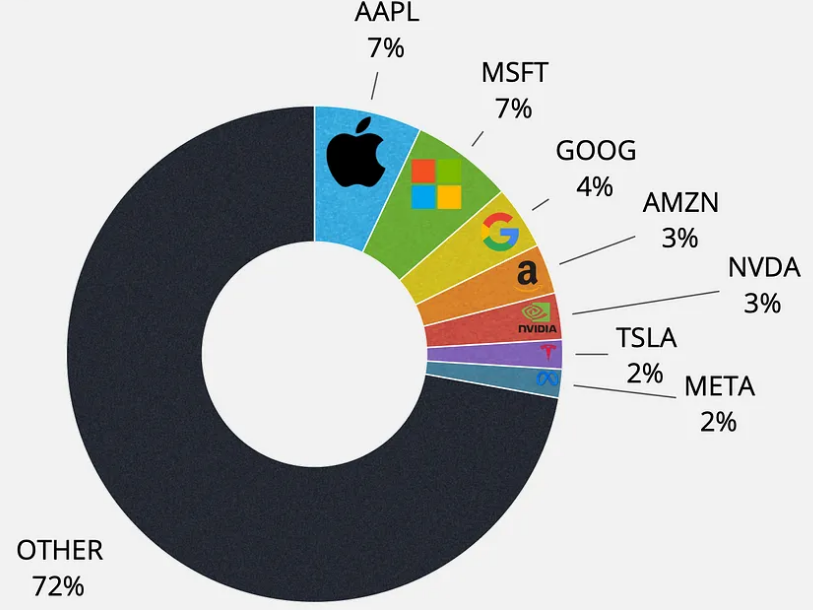
This is not an overnight success. Over the past decade, all of them have outperformed the index by 3 times or more.
In February 2013, CNBC's Mad Money host Jim Cramer introduced an acronym for future stocks. He called them FANG (Facebook, Amazon, Netflix, Google) stocks and suggested they have "the potential to really take a bite out of the bears." The acronym has gone through many changes since then, from FAANG (with the addition of Apple) to FAAMG when Microsoft acquired Netflix. But the Western action-inspired term "The Magnificent Seven" may be here to stay.
According to the strategy group According to Goldman Sachs Goldman Sachs, these seven stocks haven't been this cheap in six years on a price-to-earnings basis (assuming they meet expectations). However, research has shown that mega-cap stocks can sometimes underperform smaller companies due to various factors, including less opportunity for growth and increased scrutiny.
From a regulatory perspective, they are often considered modern monopolies. They're all under government scrutiny, from antitrust lawsuits to reviews of potential anticompetitive behavior.
With another earnings season on the horizon, let's look at the key results from the previous quarter for all seven members of this group.
Briefly about today:
1. Apple: 1 billion subscriptions.
2. Microsoft: data first, artificial intelligence second.
3. Alphabet: all roads lead to artificial intelligence.
4. Amazon: LLM as a service.
5. NVIDIA: In a league of its own.
6. Tesla: accelerating the future.
7. Meta: Open Source AI.
1. Apple
As always with Apple, there's more to this story than meets the eye. Headlines too often focus on iPhone revenue.
From record Services revenue to recovery in China and potential foray into artificial intelligence, the tech giant remains a compelling example of sustainability and growth.
In the second quarter of fiscal 2023, services accounted for 41% of Apple's gross profit (+2pp compared to last year). It's only a matter of time before Apple gets the majority of its gross profit from this segment. The company recently reached 1 billion paid subscriptions with an install base of 2 billion active devices.
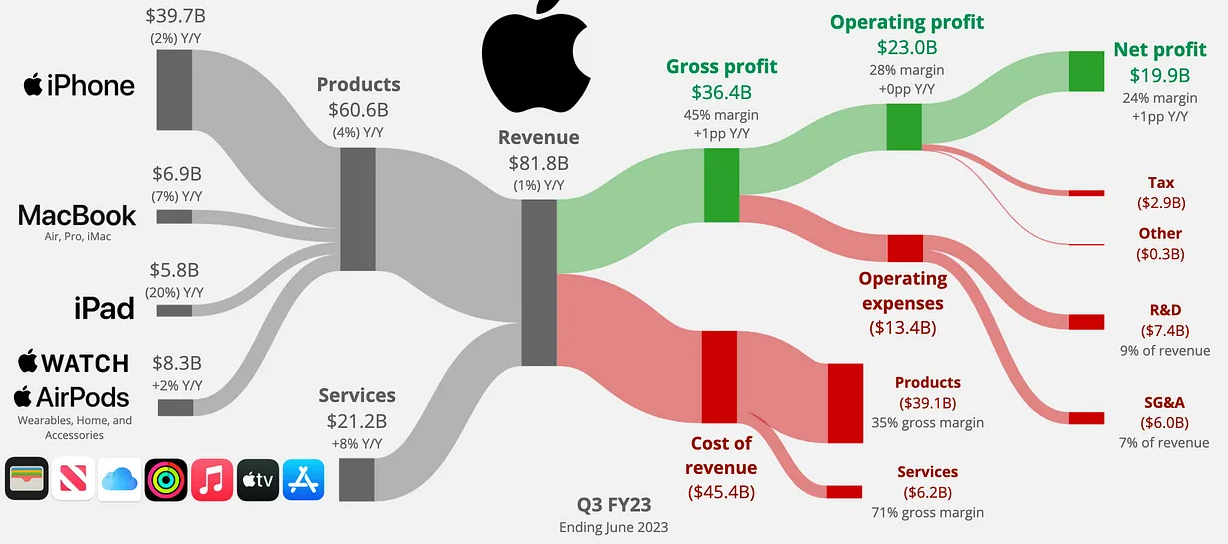
2.Microsoft
As Microsoft CEO Satya Nadella notes:
“Every AI application starts with data, and having a comprehensive data and analytics platform is more important than ever.”
A successful AI strategy starts with a strong data strategy. In this article, we will look at new initiatives that will impact future growth.
AI Copilot: Considered the “third pillar” of the productivity and business process segment, combining creation tools and communication and collaboration services.
Bing Chat Enterprise: Chatbot for ultra-sensitive data.
Microsoft Fabric Microsoft Fabric: A new end-to-end data and analytics platform that integrates with all cloud providers.
Cloud operations remain a cornerstone, although recent trends hint at a slowdown. And, of course, we still have the pending acquisition.

3. Alphabet
CEO Sundar Pichai reminded us that the implementation of artificial intelligence in Alphabet products impacts billions of people. From Gmail to photos to the Android OS, all roads lead to artificial intelligence.
The company posted its fastest revenue growth since Q2 FY22.
In an ongoing antitrust case, Microsoft CEO Satya Nadella has revealed that even Microsoft is struggling to compete with Google's dominance in search. Nadella suggested that Google's leadership in this area could expand further thanks to the benefits of AI-driven data and the self-reinforcing flywheel effect.

4. Amazon
The Federal Trade Commission (FTC FTC) recently stated that Amazon maintains and abuses an online retail monopoly. It's unlikely, but if the agency wins the case, it could demand structural relief, which would mean breaking up the company.
While Amazon significantly improved its free cash flow in the second quarter of FY23, Wall Street was primarily focused on bullish sentiment around a possible bottom in workload optimization.
From infrastructure to models to applications, AWS serves three layers of the AI technology stack. Recent investments in AI startup Anthropic (up to $4 billion) show that the battle for generative AI is heating up.
Revenue grew to 22% year-over-year and became the fastest-growing segment.
Subscriptions continued to grow at double-digit rates.
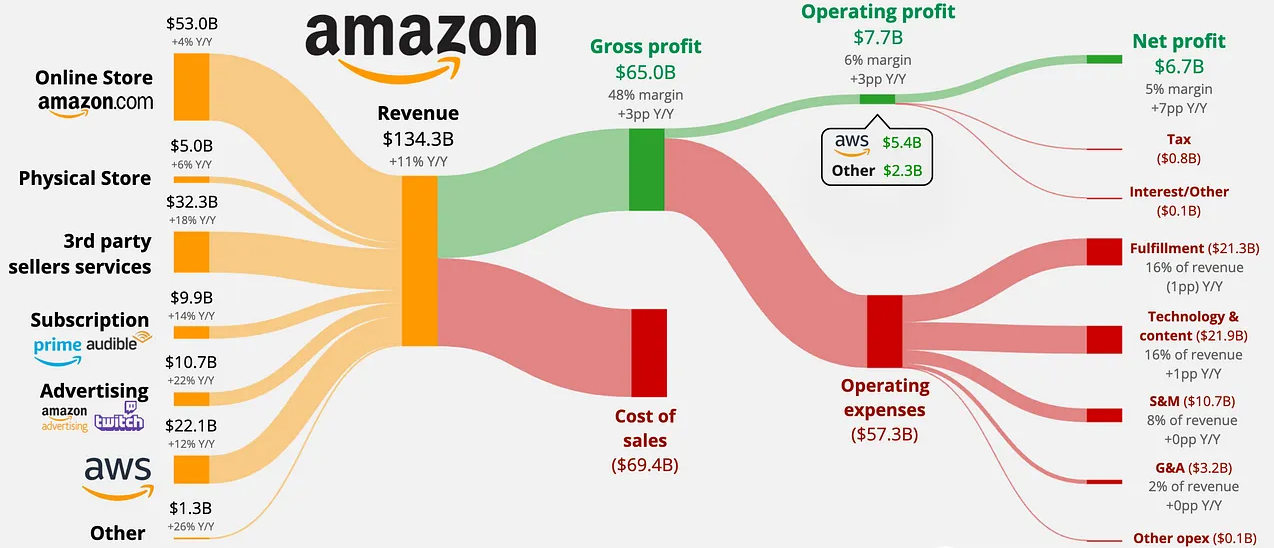
5. NVIDIA
NVIDIA delivered another stunning earnings report for the second quarter of fiscal 2024 (ending July 2023). CEO Jensen Huang concluded the earnings call with a strong message for the market.
“The industry is simultaneously experiencing a transition to two platforms: accelerated and generative artificial intelligence. Data centers are moving from a general purpose platform to accelerated computing. Global $1 trillion data centers will shift to accelerated computing to achieve orders of magnitude greater performance, energy efficiency and cost.”
Data centers accounted for 76% of revenue, leading to a surge in demand for generative AI and large language models (LLM).
Three main customer categories are driving this growth:
Cloud service providers (CSPs) accounted for more than 50% of data center revenues. All hyperscalers (Amazon, Microsoft, Google) are NVIDIA customers with high demand for the flagship H100 GPUs for the data center.
Consumer Internet companies were the second largest category. For example, Meta equips its Grand Teton AI supercomputer with H100 chips. AI helps increase time spent on Instagram and improve advertising effectiveness.
Enterprises. Demand for artificial intelligence and accelerated computing is affecting every sector, from automotive to finance to healthcare. All receive an LLM degree. They get access to NVIDIA acceleration libraries, pre-trained models, and APIs.
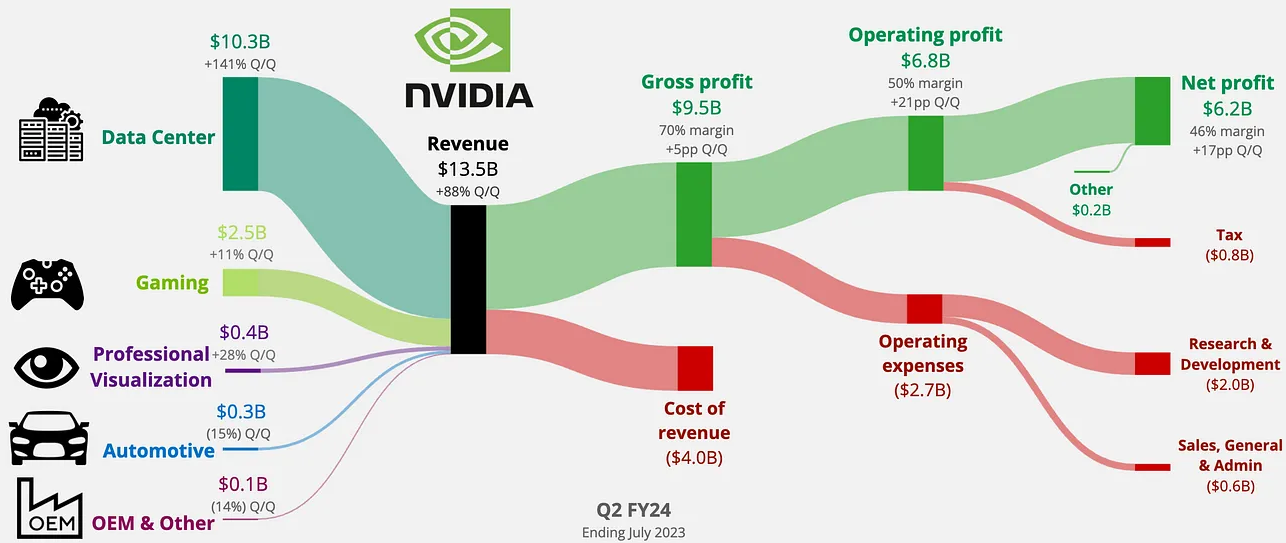
6. Tesla
In a challenging economy and highly competitive EV market, Tesla strategically wants to adapt to changing demand. However, this approach led to a decrease in profits.
Elon Musk explained during the latest earnings call:
“Short-term variations in gross margins and profitability are actually minor compared to the long-term picture. Autonomy will make all these numbers look stupid.”
The strategy is clear. Musk is willing to sacrifice profits today to increase profits tomorrow, primarily through additional software sales. Tesla is still on track to produce 1.8 million vehicles in 2023, up from 1.3 million in 2022. Thus, the growth trajectory will continue, although profitability will be lower for now.
Several auto companies, such as Ford and GM, have announced that they will adopt NACS—Tesla's charging standard—for their North American products. This could speed up the transition to electric vehicles and spur the growth of Tesla's charging network.
Meanwhile, Tesla has logged more than 300 million miles driving the beta version of the Meanwhile, FSD FSD. By early 2024, the company expects its own supercomputer (Full Self-Driving), designed to train neural networks and improve autonomous driving algorithms, to be among the top five in the world in terms of computing power. This reinforces Tesla's data advantage in FSD beta.
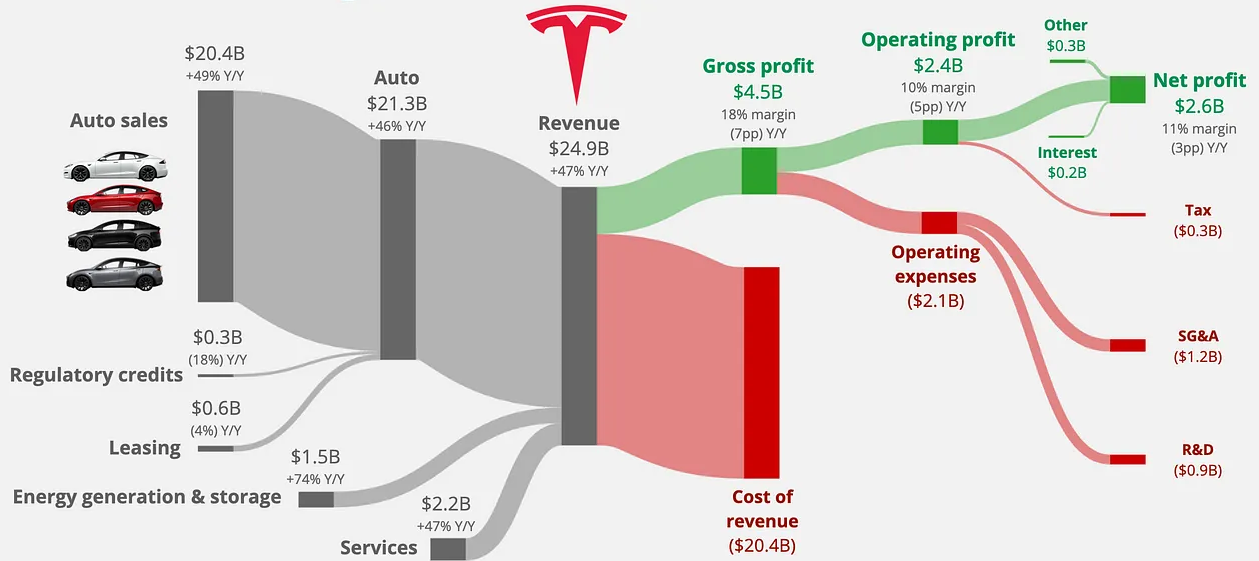
7.Meta
Facebook added 27 million daily active users sequentially to its existing base of 2 billion users in the second quarter, indicating that the exodus of users has yet to materialize. Across the entire family of apps, Meta reaches more than 3 billion daily active people, growing 7% year over year.
Founder and CEO Mark Zuckerberg discussed the various ways the company can benefit from artificial intelligence using the Llama model and shared his thoughts on Reality Labs for the long term. This vision became even more concrete at the recent Meta Connect event, where the company announced Meta AI Meta AI: Chat-GPT-style assistants built into meta apps.
3 Meta Quest 3: The VR headset update (released October 10th) took center stage. This device will be crucial as it is the first major release in three years and will have an edge over Apple's Vision Pro.
Ray-Ban Smart Glasses - These glasses allow users to live stream without being noticed. More importantly, the glasses will have access to Meta AI, which can test computer vision and ensure seamless integration of AI assistants.
While Meta AI demonstrates the company's commitment to leveraging its massive user base with integrated AI technology, the jury is still out on the success of its hardware initiatives. So far, the product's rollout has been timid, and there's no evidence that things will be any different this time.




















